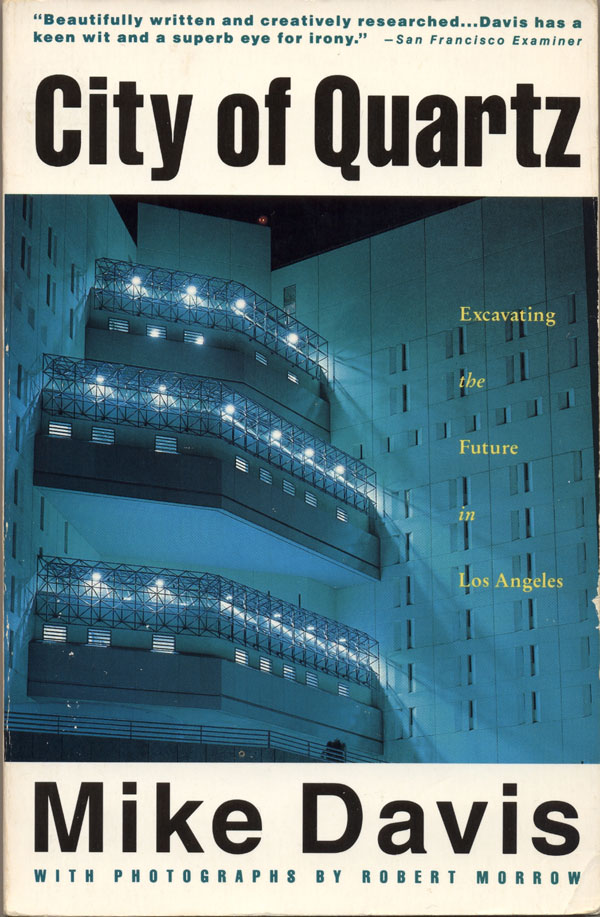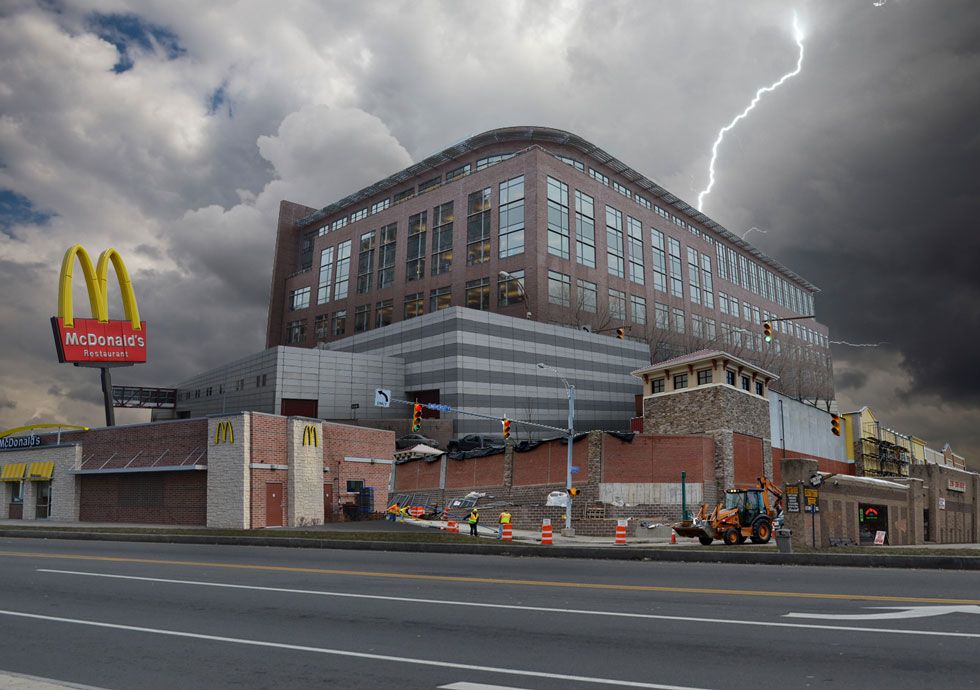This article was scraped from Rochester Subway. This is a blog about Rochester history and urbanism has not been published since 2017. The current owners are now publishing link spam which made me want to preserve this history.. The original article was published February 13, 2013 and can be found here.
![Dehumanizing architecture like this has been popping up all over Rochester for decades. [IMAGE: RochesterSubway.com]](https://senseofplace.dev/content/images/photos/fortified-rochester.jpg)
The following is a guest post submitted by Joel Helfrich .
Submit your story today .
You do not have to be a designer to see that Rochester has a problem--well, a number of problems, actually. That we continue to make the same mistakes, however, regarding design of our built environment, is perhaps one of the most egregious. This column highlights some of the worst offenders in Rochester--some of which are still being built...

Nearly every example brings to mind historian Mike Davis's magnum opus: City of Quartz: Excavating the Future in Los Angeles (1990)

. The title reminds me of attempts in Rochester such as through the Rochester Regional Community Design Center, Rochester Subway, Reconnect Rochester, and various enlightened architects to draw attention to the social, cultural, and design-based decisions that allowed Rochester to have much of the bad architecture that it has today. People in Rochester are trying to fix this problem, however, in an attempt to bring back design standards that worked: housing atop storefronts, buildings built to abut the street for easy access to rail, rail systems that promoted vibrant, productive urban centers, streets that promoted walkability, et cetera. Davis's fascinating sequel, titled Ecology of Fear: Los Angeles and the Imagination of Disaster (1999)

, builds on his first book by continuing to show with devastating reality how Angelenos fail to realize the disconnections between their lives and the physical surroundings.
I found Davis's book convincing as an undergraduate and again as a graduate student. I recently reread the book and found it not so radical--tame, in fact--than I had remembered it. His descriptions of prisons, no-go areas, fortresses, windowless buildings, and unwelcoming places, many of them created intentionally, made me think about my own city. Whilst thinking about his work, I considered especially what designs the City Planning Commission must have approved within the last 10 years--quite clearly a great amount of schlock. What follows are some examples of horrible places and architecture that might actually be doing damage and harm to our residents and visitors of the city. Clearly these are not welcoming spaces, nor do they evoke a sense of pride, health, or happiness:
![Rochester Riverside Convention Center. South Avenue. [PHOTO: RochesterSubway.com]](https://senseofplace.dev/content/images/photos/rochester-riverside-convention-center.jpg)
The Rochester Riverside Convention Center

is a case in point. The front is not better than the back along South Ave or from the Broad Street Bridge. The front along Main Street, although it has some windows, is separated from the people on the street by railings and concrete. This building created an entire block that is now a wasteland, devoid of people and brimming with cars all heading one direction: away from the urban core. Rochester's main natural landmark, the Genesee River, is shielded from many views by this behemoth. A vital, cultural resource is made inaccessible for an entire block.
![Excellus BlueCross BlueShield headquarters on Court Street. Rochester, NY. [PHOTO: RochesterSubway.com]](https://senseofplace.dev/content/images/photos/rochester-excellus-blue-cross-blue-shield.jpg)
The Excellus BlueCross BlueShield headquarters

nearby spans an entire block in nearly every direction, yet appears from most angles to lack an entrance or exit or any doors, its employees trapped in a corporate structure that, as the Eagles put it in "Hotel California": "You can check-out any time you like, But you can never leave!" Even from a safety standpoint, this offense seems astonishing.
![xxx [PHOTO: RochesterSubway.com]](https://senseofplace.dev/content/images/photos/rochester-mcdonalds.jpg)
The planning people in City Hall do not appear to be getting any better at the process of approving new construction. The intersection of Main and Culver recently saw the sprouting of a new McDonald's where an old McDonald's once stood, but the sitting of the building to the corner is notable because of its windowless back to the intersection. In fact, one section of the building facing Culver Road gives the impression, because of a separate brick color, that the windows were bricked in. The back door, often with plastic pallets and metal dolly just outside, faces the intersection. It locks down the corner. Its design is solely for the benefit of cars that drive through the back (front?) of the building that faces the neighborhood. McDonald's was just the latest piece of the puzzle that is the intersection of Main and Culver. The high security windows (reflective glass!), doors, and set-back of the Volunteers of America, as well as the drive-through clothing drop-off, harms another corner of the intersection. The old Papa John's and East High, with its miles of chain link fence, do little to make the other corners of this intersection

any better. Clearly the message is well taken here: the needs of neighbors and people travelling by foot or bicycle are secondary to cars. Moreover, impoverished neighborhoods are not worthy of good design.
![Postler & Jaeckle on South Avenue. Rochester, NY. [IMAGE: Google Street View]](https://senseofplace.dev/content/images/photos/rochester-postler-and-jaeckle.jpg)
But even up-and-coming neighborhoods like the South Wedge have felt the burden of bad design. Postler & Jaeckle's addition to its headquarters

on the corner of South Ave and Hickory Street, with its high windows and long expanses of brick, is dreadful. While it may serve its purpose as a storage area for P&J's equipment and supplies, it does nothing to add to the area around it, the new businesses and housing on South Avenue, the surrounding architecture, or any feeling of peacefulness.
![EchoTone Music on South Avenue. Rochester, NY. [PHOTO: RochesterSubway.com]](https://senseofplace.dev/content/images/photos/rochester-echotone.jpg)
Nearby EchoTone Music

on South Ave reminds me of a Medieval Times restaurant chain or, better still, a brown colored White Castle restaurant--fortress-like in design and appearance. Yet even the average White Castle, the original hamburger chain, has windows.
![James PB Duffy School #12 on South Avenue. Rochester, NY. [PHOTO: RochesterSubway.com]](https://senseofplace.dev/content/images/photos/rochester-james-pb-duffy-school-12.jpg)
Perhaps the worst offender of the South Wedge is School Number #12

, in part because it is supposed to be a place for children to learn. Its Soviet style prison-like architecture is extremely oppressive. Even the lunchroom does not have windows, a terrible environment for little children who attend that school yet must close their eyes to imagine a life outside of concrete. Parts of Highland Hospital are also atrocious, especially the parking garage on the corner of Rockingham and South, but also the back of the hospital along Rockingham and Mount Vernon.
![The new East Avenue Wegmans as seen from Winton Road and University Avenue. [PHOTO: RochesterSubway.com]](https://senseofplace.dev/content/images/photos/rochester-wegmans.jpg)
Last, but certainly not least: the forgettable East Ave. Wegmans

, which opens in May. Many people are drawn to the Wegmans chain. My relatives take visitors to Wegmans. People who move away from the area wish that they could take a store with them. Overflowing with proprietary architecture, fake windows, and security glass, the new East Ave. Wegmans is the latest edition to our social and cultural fabric--our built environment. Many people view Wegmans as an "institution." After all, it is less museum and more prison like, in my opinion. It is not hard for your average Rochesterian to recognize the brand. It is the same shoddy inferior design, no matter if you are in Pittsford

or Geneva

, New York; in Virginia

or Maryland

; or on East Ave. in Rochester. That there was ever a fight over this place from City officials and the City Planning Commission seems hard to imagine, given that it looks exactly the same as the last local Wegmans built in Greece on Mount Read

. This abysmal place features nearly three sides of a "new" building in an "old" wrapper without windows, greenspace, or anything that makes a human feel happiness, healthiness, or wellness. Let us not forget the massive parking lot. As my late father-in-law would put it: "Sons a bitches!"
There has to be a different way of doing business in Rochester. Couldn't the City create a green code so we can be like Buffalo or obtain some additional green infrastructure with plans similar to Syracuse? Imagine permeable paving, a green roof, solar panels, a small wind turbine (not banned by Rochester city code, yet), a green wall, bioswales, a rain garden, water harvesting from the roof, et cetera. The list goes on!
The questions from looking at and thinking about all of Rochester's sad places remain: will Rochester continue to fortify itself, creating spaces that are not worth anything? Or will we turn the tide and make aesthetically pleasing places that are worth caring about? The former is most likely what this City will do, but I would love to hear your opinions and learn about the places in Rochester that make you feel sick, as well as those that continue to lift your spirits.
* * *
About Joel Helfrich:
Joel Helfrich is an Adjunct Assistant Professor of history at Monroe Community College and a Visiting Assistant Professor of Environmental Studies at Hobart and William Smith Colleges. Joel is also a father, entrepreneur, educator, and activist who has worked on animal rights, environmental, historic and sacred sites preservation, and social justice issues. He holds the conviction that a myopic focus defeats the most important work any historian does--being an informed and informative member of society. He sees the environment as a site where much of his historical training can be brought to bear, so he continues to pursue those interests as well as others.


